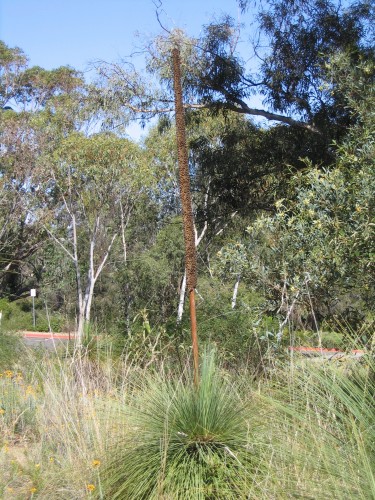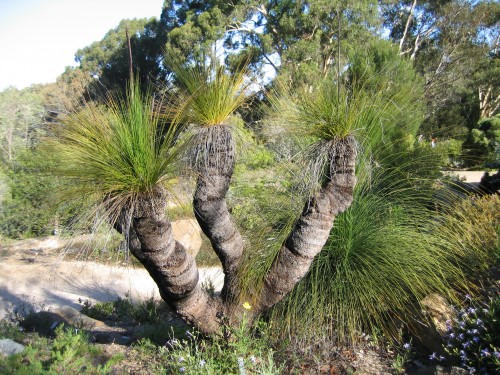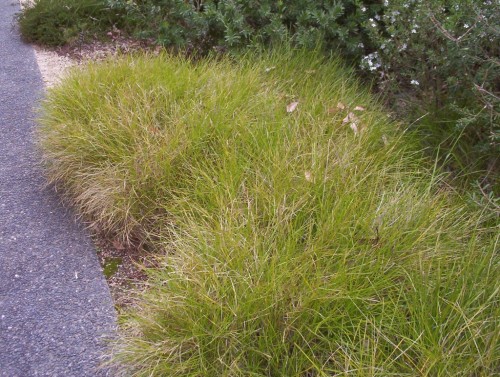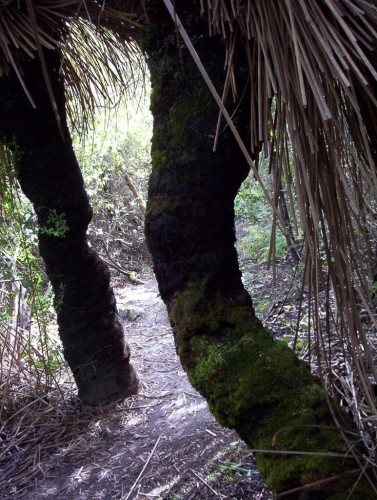Anigozanthos flavidus (Tall Kangaroo Paw)
I have just planted three of these plants. They were quite tight in their pots but were making new shoots so I decided to take a chance and put them in as they were. Mine are a yellow-green colour, but you can also get pink, orange, red, yellow or green, and sometimes mixed colours. The usual colour is the yellow -green
Two have gone onto a raised mound, and the third at ground level but with a dose of gypsum in case there is clay below the root ball. Mounds need only be 120 mm above ground level to achieve the drainage required.
This is the hardiest of the kangaroo paws and is used in breeding the new hybrids that are in many nurseries these days. I must say that I like the species plants even though I admire the new colours.
The strappy leaves on this plant can grow up to a metre tall and the clump to a metre across. However the flower spikes can grow to two metres . The seed I was given came from plants that had these very tall spikes and many flowers on the stalk.
It grows best in moist, light to medium soils, in partial to full sun, but will tolerate dappled shade. It can be damaged by frost.
Black ink disease is a problem in misty areas or locations where there is not enough air movement. Slugs and snails will cause a lot of damage.
Xanthorrhoea glauca ssp angustifolia (Grass Tree)
I found this plant in Canberra Botanic gardens in the bush garden with other grasses and daisies. I assume that it is native to the area around Canberra. I could not find ant direct information about the plant. Most of the time I scrabbled around the base of plants in the garden looking for the aluminium tag attached to the plant to read what the species was. Unfortunately, I forgot to check other plants in the area in case there was further information.
Judging by the type of soil and location, I suggest that this plant needs good drainage. It is obviously frost hardy as it was in an exposed situation. There was a saying amongst the Australian Plant Society members that if a plant grew in Canberra, it would survive any frost that formed in South Australia.
Xanthorrhoea johnsonnii (Grass Tree)
I was delighted to see well grown plants of Xanthorrhoea johnsonii in Canberra Botanic Gardens, which has to be my favourite Botanic Garden. This photo was taken in the dry bushland section near the daisies and rockery. They are wonderful architectural plants and look spectacular with their dark trunk. The National Botanic Garden is built on a hillside with what must be great drainage, which these bush plants need.
I discovered that Canberra city has the same annual rainfall as Adelaide, so much of what I saw growing there has a fair chance of success in Adelaide and environs.
Lomandra confertifolia ‘Little Con’
This tufted plant has been around for a while and has proved to be hardy in many locations. This particular selection has been promoted in garden centres for some time. In the photo it is being used as border plant. Lomandra confertifolia originates in Queensland with some forms appearing along the coast to Sydney. The requirements are generally filtered light and good drainage. This small form seems to be hardy in more open positions. Generally they tolerate light to moderate frosts. Grasses can be seen in this use also here.
Xanthorrhoea semiplana (Yacka, Grass Tree)
This photo was taken because it was fascinating to see the age of these Grass Trees. The walking path passed between these two trunks. There is moss growing on the trunks. I would love to at least see my little plant make the canopy of leaves showing on these.
This plant seems to be a very hardy one once established. The flower stalk can be up to two and a half metres long. They often have a kink or distortion in the spike.



